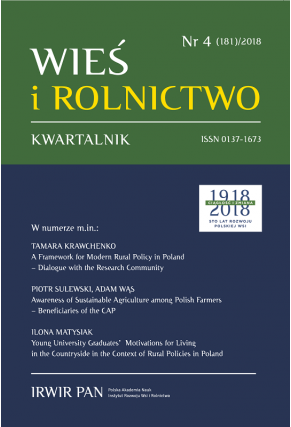Inter-Sectoral Cooperation for the Implementation of Social Policy in Rural Areas. Proposal of Research Tool
DOI:
https://doi.org/10.53098/wir042018/08Keywords:
local social policy, cooperation between entities involved in local social policy, rural municipality (gmina)Abstract
The cooperation of local public institutions with non-governmental organisations and citizens can increase chances for the effective implementation of social policy, understood as a set of activities on behalf of satisfying social needs and resolving social issues. The aim of this article is to present a tool that would enable us to determine the level of cooperation between entities in the scope of co-creation and co-production of social services that satisfy the needs of residents of rural municipalities (gmina). The article contains an overview of analyses conducted in 2018 on a sample of public institutions responsible for satisfying social needs and resolving social issues representative of rural municipalities. In light of these analyses the scale is a three-factor construct and includes the following factors: 1. Seeking entities for cooperation and cooperating with them, 2. Including residents of municipalities in undertakings on their own behalf, 3. Evaluation of cooperation and working towards future cooperation.
References
Arnstein S. (1969). A ladder of citizen participation. Journal of the American Planning Association, 35 (4), 216–224. DOI: https://doi.org/10.1080/01944366908977225
Dean R.J. (2018). Counter-governance: Citizen participation beyond collaboration. Politics and Governance, 6 (1), 180–188. DOI: https://doi.org/10.17645/pag.v6i1.1221
Furmankiewicz M., Macken-Walsh A. (2016). Government within governance? Polish rural development partnerships through the lens of functional representation. Journal of Rural Studies, 46, 12–22. DOI: https://doi.org/10.1016/j.jrurstud.2016.05.004
Grewiński M., Karwacki A., Rymsza M. (2010). Nowa polityka społeczna: Aktywizacja, wielosektorowość, współdecydowanie. Warsaw: Mazowieckie Centrum Polityki Społecznej.
Halamska M., Maurel M.-C. (eds.) (2010). Les acteurs locaux á l’épreuve du modèle europeén LEADER. Praques-Varsovie: CEFRES, IRWiR PAN.
Halamska M., Śpiewak R., Michalska S. (2010). LEADER w Polsce: Drogi implementacji programu. Wieś i Rolnictwo, 4 (149), 104–119. DOI: https://doi.org/10.53098/wir.2010.4.149/07
Hartley J. (2005). Innovation in governance and public services: Past and present. Public Money and Management, 25 (1), 27–34.
Herbst J. (2018). Nieocenione, niedocenione: Skala działań organizacji społecznych na wsi. In: J. Wilkin, I. Nurzyńska (eds.), Polska wieś 2018: Raport o stanie wsi (pp. 181–203). Warsaw: Scholar Publishing.
Journal of Laws 2003.0873. Ustawa z dnia 24 kwietnia 2003 r. o działalności pożytku pub- licznego i o wolontariacie (tekst jedn. Dz. U. z 2018 r., poz. 450).
Journal of Laws 1990.0095. Ustawa z dnia 8 marca 1990 r. o samorządzie gminnym (tekst jedn. Dz. U. z 2018 r., poz. 994).
Karolewski I. (2016). Protest and participation in post-transformation Poland: The case of the Committee for the Defense of Democracy (KOD). Communist and Post-communist Studies, 49, 255–267. DOI: https://doi.org/10.1016/j.postcomstud.2016.06.003
Leś E. (2013). Organizacje non profit w nowej polityce społecznej w Polsce na tle europejskim. Warsaw: Oficyna Wydawnicza Aspra – JR.
Marchaj R. (2016). Samorządowe konsultacje społeczne. Warsaw: Wolters Kluwer.
McLaughlin K., Ferlie E., Osborne S. (2001). New Public Management: Current Trends and Future Prospects. London: Routledge.
MIiR (Ministerstwo Inwestycji i Rozwoju) (2017). Strategia na rzecz Odpowiedzialnego Rozwoju do roku 2020 (z perspektywą do 2030 r.). Warsaw: Ministerstwo Inwestycji i Rozwoju.
Necel R., Nosal P. (2016). Samorząd województwa a lokalne podmioty polityki społecznej: Wzajemne relacje i ich uwarunkowania. Acta Universitatis Lodziensis. Folia Sociologica, 57, 131–149. DOI: https://doi.org/10.18778/0208-600X.57.09
Pawłowska A., Gąsior-Niemiec A., Kołomycew A. (2014). Partnerstwa międzysektorowe na obszarach wiejskich: studium przypadku lokalnych grup działania w województwie podkarpackim. Warsaw: Scholar Publishing.
Pestoff V. (2012). Co-production and third sector social services in Europe: Some concepts and evidence. Voluntas. International Journal of Voluntary and Non-profit Organizations, 23, 1102–1118. DOI: https://doi.org/10.1007/s11266-012-9308-7
Pestoff V., Brandsen T., Verschuere B. (eds.). (2012). New Public Governance, the Third Sector and Co-production. London: Routledge. DOI: https://doi.org/10.4324/9780203152294
Radnor Z., Osborne S.P. (2013). Lean: A failed theory for public services? Public Management Review, 15 (2), 265–287. DOI: https://doi.org/10.1080/14719037.2012.748820
Richardson L., Durose C., Perry B. (2018). Coproducing urban governance. Politics and Governance, 6 (1), 145–149. DOI: https://doi.org/10.17645/pag.v6i1.1485
Sidor M. (2017). Zlecanie zadań publicznych organizacjom pozarządowym – doświadczenia największych polskich miast. In: B. Dolnicki (ed.), Sposoby realizacji zadań publicznych (pp. 599–612). Warsaw: Wolters Kluwer.
Sześciło D. (2015). Samoobsługowe państwo dobrobytu: Czy obywatelska koprodukcja uratuje usługi publiczne? Warsaw: Scholar Publishing.
Świdyński J., Świdyńska N. (2016). Konsultacje społeczne jako narzędzie współpracy obywateli z samorządem gminnym na przykładzie Olsztyna. Prace Naukowe Uniwersytetu Ekonomicznego we Wrocławiu, 443, 245–267.
Zacharko L. (2017). Innowacyjne rozwiązania w zakresie realizacji zadań publicznych gminy w Polsce i we Francji – modele kontaktowania usług społecznych. In: B. Dolnicki (ed.), Sposoby realizacji zadań publicznych (pp. 768–778). Warsaw: Wolters Kluwer.
Zajda K. (2018). Konsultacje społeczne a proces wdrażania innowacji społecznej. Samorząd Terytorialny, 7–8, 98–108.
Zajda K., Pasikowski S. (2018). Traits of leaders of rural non-governmental organisations as predictors of collaboration between NGOs and rural gmina offices: Voices from Central Poland. Voluntas. International Journal of Voluntary and Non-profit Organizations, June 2018, 1–14. https://doi.org/10.1007/s11266-018-9999-5 [accessed: 15.08. 2018]. DOI: https://doi.org/10.1007/s11266-018-9999-5











